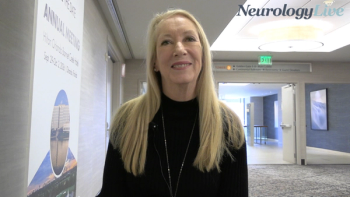
SMA: Considerations for Newborn Screening and Management
Nancy L. Kuntz, MD: I think over the years some of the studies that have been most compelling, as I think about all the children with SMA [spinal muscular atrophy], were the studies done in Utah by our colleague Kathy Swoboda, who had the opportunity to follow, on a weekly basis, some children who were known and diagnosed prenatally to have SMA. It was to follow them and look at their physiology, as you say, the neurophysiology of the compound muscle action potential amplitude and a motor unit number estimate on a serial basis, even before they had any clinical symptoms. And obviously, at that time, she had no clue whether these children were slated to be infantile onset or later onset, but she followed them nevertheless. And I think that the curves that she has published, which showed so clearly that the fall in the amplitude of the motor response and the estimate of the numbers of motor units, occurred so clearly well before the clinical symptoms appeared. I think this is 1 of the things that has really been on my mind as we begin this new era in spinal muscular atrophy in which we can talk about potential treatment.
Because if, in fact, you’ve had an exponential loss of your motor neuron numbers prior to onset of symptoms, just trying to be very astute and come up with an early clinical diagnosis may not be enough. And so I think this has led to what many of us have been involved with, trying to discuss and promote the national effort to do newborn screening for spinal muscular atrophy. As we all know, this did pass through the committee that makes recommendations of newborn screening practices to the secretary of the Department of Health and Human Services. But still, in our country, the process is quite cumbersome and complicated in that each state has to invoke and create its own method for doing newborn screening.
Even though there are a few states now that have voluntary or pilot studies ongoing, it’s certainly not something that is widespread quite yet. But I think it’s very much worth talking about even before we finish this section on diagnosis. What are your thoughts about newborn screening?
Elizabeth Kichula, MD, PhD: Newborn screening, I think, has been hugely exciting to see. As we’ll talk about with the new treatments, the earlier we start treatment is the biggest key to seeing what these outcomes look like. We’re all very excited to have newborn screening start, and really every couple of months it seems as if there’s another state or 2 that’s added to the list. While it’s quickly expanding, it does take time to kind of get widespread. When we do this, it’s interesting because we will pick up on a lot of patients who potentially we wouldn’t have otherwise met for many years. In general, the newborn screening is only screening for the deletion in SMN1. So that’s important to know because we are missing the point mutations. So there will be some patients with 5q SMA who will get missed on the initial newborn screen.
Nancy L. Kuntz, MD: And what fraction would you estimate that to be? That’s going to be about?
Elizabeth Kichula, MD, PhD: I think 3% to 5% is where all the papers have shown that to fall in. So that will be an important thing to remember, and it may make the diagnosis harder because there will be few of us who will be used to seeing that acute disease, the same way we have a harder time diagnosing measles these days. The other thing that we will find is it will give us kids who have 1 copy of SMN2, 2 copies, 3, 4, even more than 4. And so that’s going to produce interesting questions about when we initiate treatment going forward, particularly for those patients with a higher SMN2 copy number.
There are some recent guidelines that came out about newborn screening and the initiation of treatment. And these are expert guidelines from a group of people sitting in a room with pretty much a universal recommendation that any baby with 2 or 3 copies—the chances would be a type 1 or type 2 infant—should be offered treatment at birth. But once you get to those who have 4 or more copies and may not present symptomatically for quite some time, there’s a little bit more debate. And I think those are going to be continual challenges for us to address going forward.
Claudia A. Chiriboga, MD, MPH: Basil, I think you have strong views with regard to 4 copies and treatment.
Basil Darras, MD: Yes. During this discussion regarding how we’re going to treat babies who are born with different copy numbers—SMN2 copy numbers, as Liz said—there was consensus in the area of 2 and 3 copies because babies who have 1 copy of SMN2 have SMA type 0. And as you know, they have prenatal onset. The vast majority are really very impaired, and therefore everybody felt that perhaps treating those babies is not necessary. But that will be left to the discretion of the neurologist, because maybe there will be exceptions to that. There might be a few babies who are actually stronger than expected for type 0.
Now, coming to the group of babies who have 4 or more copies of SMN2, we did not reach consensus, because some of my colleagues felt that we can follow these babies clinically by using electrophysiology periodically, following their CMAP [compound muscle action potential] values, trying to find early signs of the disease, and then treating if the child seems to have signs of SMA. Some of the other colleagues and I felt that this approach is not very accurate, given that the physical exam is not properly reliable. It could be that some signs could be misinterpreted, or it could be that the followup is not as close as it’s supposed to be. And also following CMAP amplitudes is subject to technical issues, and it’s possible that you may not detect, reliably, reduction in the CMAP amplitude for different reasons.
So we felt that we should probably treat even the babies who have 4 or more copies of SMN2 because, again, the detection of disease onset is not very accurate. And by the time these babies develop those symptoms and signs or electrophysiological findings, by then they’ve lost a significant number of motor neurons. And I don’t think that would be acceptable if it’s totally preventable. Again, there was no consensus, and therefore this area is still debated.
Nancy L. Kuntz, MD: I think the issue of newborn screening would probably be very reasonable for us to circle back to once we have had a chance to talk a little bit about the treatments that are emerging. Because I think that those points are very, very valid.
Newsletter
Keep your finger on the pulse of neurology—subscribe to NeurologyLive for expert interviews, new data, and breakthrough treatment updates.




































